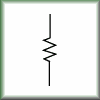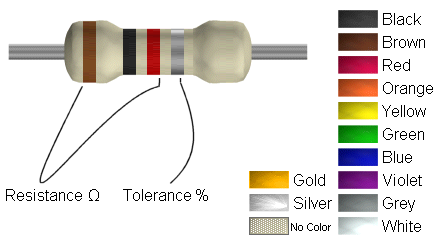Difference between revisions of "Resistor"
m (→Resistor Color Code) |
m (Reverted edits by Atekysepiko (Talk); changed back to last version by Admin) |
||
| (2 intermediate revisions by 2 users not shown) | |||
| Line 43: | Line 43: | ||
Silver | | | x 0.01 | 10 % | Silver | | | x 0.01 | 10 % | ||
--------------------------------------------------- | --------------------------------------------------- | ||
| + | |||
| + | [[Image:Resistor4bandcolor.png]] | ||
=== Chart: 5 color bar resistors === | === Chart: 5 color bar resistors === | ||
Latest revision as of 11:49, 24 November 2010
A resistor will resist the flow of electricity equally in both directions. It is defined as a circuit element that presents a resistance to the flow of electric current. A current flowing through a resistance will create a voltage drop across that resistance in accordance with Ohm's law.Electrical energy is converted to heat when current flows through a resistor. Usually the effect is negligible, but if the resistance is low (or the voltage across the resistor high) a large current may pass making the resistor become noticeably warm. The resistor must be able to withstand the heating effect and resistors have power ratings to show this.
Resistors are made in a variety of ways because their particular characteristics and accuracy suit certain areas of application, such as High Stability, High Voltage, High Current etc, or are used as general purpose resistors where their characteristics are less of a problem. Some of these characteristics are; Temperature Coefficient, Voltage Coefficient, Noise, Frequency Response, Power and Temperature Rating, Physical Size, and Reliability.
Contents
Resistor Types
Modern resistors can be classified into four broad groups;
- Compostion resistors.
- Film resistors.
- Wirewound resistors.
- Semiconductor resistors.
Wirewound Resistors
These are made from winding a metal alloy wire (Nichrome) or similar wire onto an insulating ceramic former.
Noninductive Resistor
- A wire-wound resistor constructed to have practically no inductance, either by using a hairpin winding or be reversing connections to adjacent sections of the winding.
Resistor Color Code
The resistor color code is a coding system of colored stripes on a resistor to indicate the resistor's value and tolerance. The resistance indicated by the color code is in Ohms.
Chart: 4 color bar resistors
Color 1. 2. 3. 4. --------------------------------------------------- Black | 0 | 0 | - | Brown | 1 | 1 | 0 | Red | 2 | 2 | 00 | Orange | 3 | 3 | 000 | Yellow | 4 | 4 | 0 000 | Green | 5 | 5 | 00 000 | Blue | 6 | 6 | 000 000 | Violet | 7 | 7 | | Gray | 8 | 8 | | White | 9 | 9 | | Gold | | | x 0.1 | 5 % Silver | | | x 0.01 | 10 % ---------------------------------------------------
Chart: 5 color bar resistors
More accurate resistors have 5 color bars. To read their value in ohm use the following table:
Color 1. 2. 3. 4. 5. --------------------------------------------------- Black | 0 | 0 | 0 | - | Brown | 1 | 1 | 1 | 0 | 1 % Red | 2 | 2 | 2 | 00 | 2 % Orange | 3 | 3 | 3 | 000 | Yellow | 4 | 4 | 4 | 0 000 | Green | 5 | 5 | 5 | 00 000 | Blue | 6 | 6 | 6 | 000 000 | Violet | 7 | 7 | 7 | | Gray | 8 | 8 | 8 | | White | 9 | 9 | 9 | | Gold | | | | x 0.1 | Silver | | | | x 0.01 | ---------------------------------------------------

